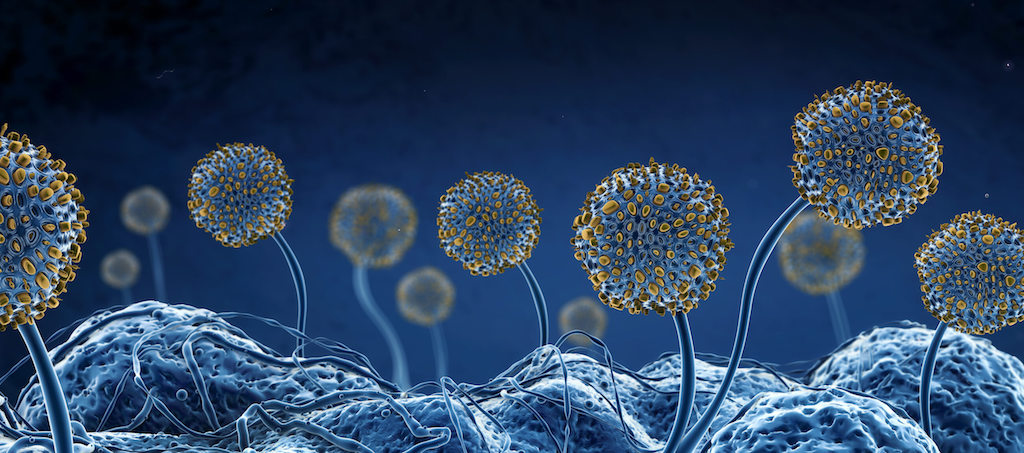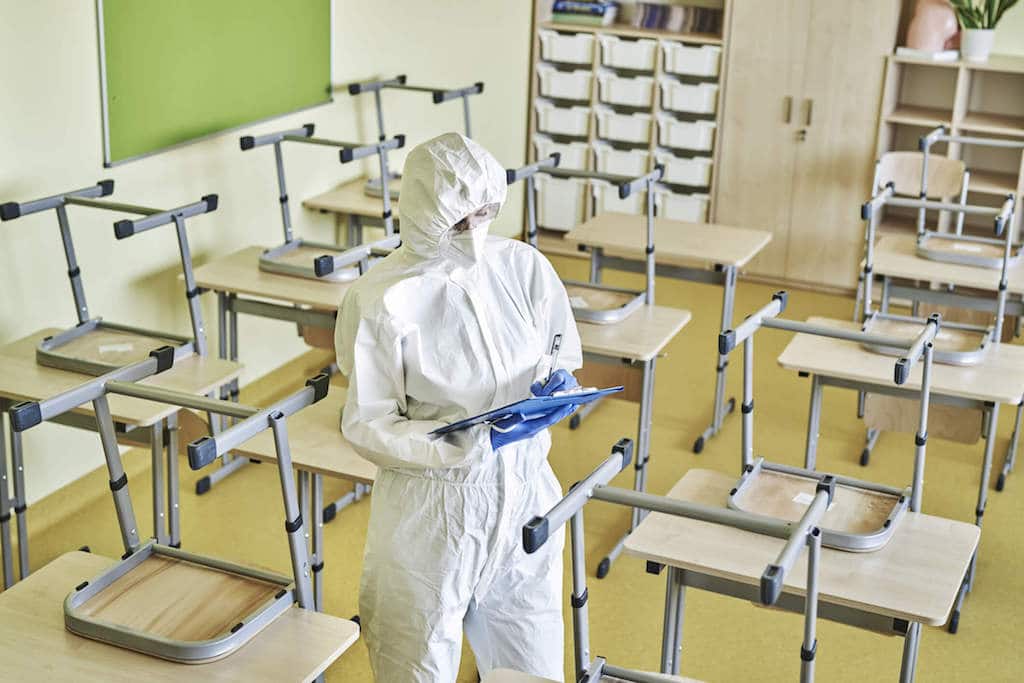When’s the last time you sat down and thought, “Is there mold in my child’s school?” Probably not often (if ever), and you’re not the only one!
Mold isn’t usually at the top of a parent’s list when it comes to sending their kids to school every morning. We’re usually focused on homework, school projects, sports events, and just getting them to the door on time. It’s a full-time job!
Just because we don’t consider mold, doesn’t mean it’s not a problem in schools. When you think about it, they’re perfect locations for this fungus to begin growing. Schools are huge buildings, heavily trafficked by a revolving door of children and staff, and they experience regular temperature fluctuations.¹ See? Mold oases in the making.
Schools across the nation already report mold problems frequently throughout the year.
That’s a problem because mold growth significantly impacts the air quality that your child breathes in for nearly a third of the day. Since children are especially at risk, mold in schools should be a topic we as parents collectively begin to consider and take action to prevent.²’³’⁴ All it takes to start this shifting dynamic? Understanding mold and helping to create better awareness!
ALL THINGS MOLDY
Mold is a type of fungus that reproduces asexually and creates little spores that it shoots out into the air.⁵ Kind of like a dandelion puff when it releases its seeds into the wind. Like the fluffy weed, these spores can end up anywhere, inside or outside. And with tens of thousands of species identified so far, they’re pretty much everywhere.⁵

There are probably a few rogue spores around you right now as you’re reading this. You’d never know, though, because they’re invisible to the naked eye.
Mold is an unavoidable part of nature. The issue begins when these microscopic spores find a habitable place inside to settle into and begin colonizing. Being the hardy little fungi they are, mold spores need very little to survive and thrive. Given oxygen, a temperature between 40-90 degrees Fahrenheit, food (they eat pretty much anything), and moisture, these spores will be well on their way to colonization.⁶
Most temperature-controlled indoor environments contain all the ingredients necessary for mold growth, minus one key aspect: moisture. That’s why it’s so important to keep an eye out for any moisture-related events that spores can maximize on. Add in their ability to grow in as little as 24-48 hours and a damp building can quickly turn into a moldy problem.
Once colonization begins, the growing mold pumps more and more spores into the air. That drastically affects indoor air quality and can cause a range of adverse health effects. To make matters worse, some species of mold can also create microscopic toxins, called mycotoxins, when they feel threatened.⁷ They pump these invisible toxins into the air, further decreasing indoor air quality, and they can stick to any surface they come into contact with. And yes, these too can cause a laundry list of health symptoms.
MOLD AND HEALTH
Mold exposure is unique in the fact that it affects everyone differently. Some individuals do not experience symptoms, some experience minor symptoms, and some experience severe reactions.
A few factors make certain individuals particularly susceptible to mold exposure. Those with compromised immune systems, like those suffering from a preexisting illness, and individuals with developing immune systems, like children, are particularly prone to feeling these adverse health effects. Their immune systems are simply not equipped to deal with the influx of foreign particles they are exposed to in that indoor space.
For a child with a preexisting condition, mold in schools can be an absolute nightmare to deal with. Not to mention the headache (sometimes literally) for any school staff member who is hard at work teaching students and suffering from mold exposure symptoms at the same time.

Researchers are still hard at work determining exactly how mold exposure affects health, but they have noticed a correlation between certain symptoms that can range from mildly irritating to severe.⁸
POTENTIAL SYMPTOMS INCLUDE:
- Coughing
- Sneezing
- Watery eyes
- Chronic fatigue
- Neurological issues
- Respiratory system issues
- Digestive issues
Again, it all depends on the inherent sensitivity of the individual.
The problem is that these symptoms won’t go away until the root cause of the problem is taken care of: mold. Otherwise, exposure will continue to hammer at the child’s or staff member’s immune system every day they’re in the school building.
WHY IS THERE MOLD IN SCHOOLS?
Mold can happen to any building, at any time if moisture is present. That’s fairly easy to accomplish. Mold in schools can occur particularly easily due to the size and use of the building.
Mold in schools can pop up from a roof leak, open windows, constantly wet bathrooms, plumbing leaks, flooding, or a poorly designed or malfunctioning HVAC system. Another tick towards increasing the chance for mold colonization is the constantly fluctuating temperature of the building. Many schools turn off the air or heat when students and staff aren’t in the building. Especially during those long, hot, and humid summer months. This heavily impacts the humidity in the indoor air, leading to potential condensation and a moisture-filled building.
Hello, perfect mold habitats!
ASKING THE HARD QUESTIONS ABOUT MOLD IN SCHOOLS
With the relative ease that mold can take root in school buildings, it’s up to us parents and school staff to address this health issue. That means asking the school board hard mold questions. Do they have a plan to prevent mold growth and to treat the situation should the fungus be discovered?⁹
SOME QUESTIONS REGARDING MOLD IN SCHOOLS CAN INCLUDE:
- Did any water events occur recently?
- How were these events managed?
- When was the last time the HVAC was assessed?
- How often is the air quality in the building tested?
- Are groups of students and teachers experiencing symptoms?
- How often is the building checked for potential mold problems?
- If a mold problem is found, what is their course of action to thoroughly remediate the issue?
Many schools are overloaded with a variety of issues, ranging from academic goals to funding. But when children’s and staff’s health are on the line, getting answers to these questions is important. The lack of mold awareness needs to be addressed so school district personnel are equipped to handle this environmental crisis. They need to make plans and implement strategies so those inside the building are safe from mold exposure and poor air quality.
EXISTING MOLD IN SCHOOLS
If mold exists in the building already, the school board needs to properly address the issue. That includes hiring a qualified mold inspector to come in and assess the full scope of the problem, determining how to properly get rid of the mold, and hiring a remediation team if necessary. The cost for this process may be high (it’s a big building!), but it’s worth it to avoid health issues for those that are inside.
The mold inspector hired should assess the entire building, top-to-bottom, and use a variety of measuring techniques. This person creates a detailed roadmap of the problem so that the building is properly disinfected. If other problem areas are left undiscovered or contaminants like mycotoxins and bacteria left behind, students and staff may continue to experience symptoms from exposure.
THE SCHOOL BOARD SHOULD EXPECT TO SEE, AND PARENTS SHOULD ENSURE THEY OBTAIN, THE FOLLOWING DATA:
- Types of molds present
- Quantities of each mold
- Potential spore presence in the HVAC system
- Mycotoxin presence
- Bacterial presence
From there, the school can either handle the small mold problem using a scientifically backed disinfecting protocol. Or, if it’s a bigger issue, a remediation team can come in and thoroughly treat the mold. Make sure to stay up to date on who the school board hires to complete the remediation. This team should understand how important their task is and prioritize the health of everyone in the school building.

ULTIMATELY, THE REMEDIATION TEAM SHOULD CREATE A TREATMENT PROTOCOL WITH THREE PILLARS IN MIND:
1. Remediate the sources properly.
2. Identify and address the problems that led to those sources in the first place.
3. Eradicate all contamination created by those sources, including toxins and bacteria.
Each of these pillars must be adhered to. If the source isn’t fixed, mold growth can come back or persist. If contaminants are left behind, exposure-induced symptoms can persist. By ticking those three boxes, the environment of the school will remain safe for the students and teachers who spend their days inside.
Handling mold in schools is no easy task. Not to mention a PR, HR, and liability nightmare. That’s why understanding mold and having plans in place can help ensure the indoor space is safe and healthy. The best way to deal with mold, though, is to take as many preventative actions as possible to stop it from growing in the first place.
PREVENTATIVE ACTIONS TO STOP MOLD IN SCHOOLS
There is a list of things school boards can implement to discourage mold colonization.¹⁰’¹¹’¹² The biggest goal should be to decrease moisture as much as possible.

A FEW STEPS THEY CAN BEGIN TAKING ASAP INCLUDE:
- Maintain low indoor humidity (less than 50%) all year.
- Keep wet areas like bathrooms and kitchens well ventilated and as dry as possible.
- Regularly perform maintenance.
- Clean all surfaces frequently and thoroughly using EPA-approved products and HEPA vacuums.
- Frequently conduct school building inspections to check for mold or potential problems.
- Take care of leaks or water events immediately.
Keep in mind, these are just a few actions schools can begin implementing.
It will be up to the school board to actively come up with a protection protocol and to determine exactly how they want to mold-proof their schools. The EPA created a guideline with even more suggestions for schools to implement.¹³ Contacting air quality experts for professional opinions is another phenomenal way to ensure schools are kept safe.
MOLD-FREE EDUCATION
Mold should not be a classmate that children go to school with. Most of the time, it’s a struggle to get them into the school building and learning in the first place. Throw in mold exposure and they’re doubly miserable.
As parents, our job is to keep our kids as safe, healthy, and happy as possible. That includes protecting them against invisible threats. While mold in schools may not often be something we consider, it can drastically impact a child’s life. A persistently sick child is a parent’s worst nightmare. Especially when doctors can’t seem to come up with the cause.
By creating mold awareness and pushing for change, we can help ensure mold in schools doesn’t get the chance to harm the students and staff within. It’s just another badge for hero parenting and a step towards ensuring the continued health of the minds of the future.
- Environmental Protection Agency. (n.d.). Mold in Schools and Commercial Buildings. EPA. Retrieved September 23, 2021, from https://www.epa.gov/mold/mold-schools-and-commercial-buildings.
- Santilli, J. (2002). Health effects of mold exposure in public schools. Current Allergy and Asthma Reports, 2(6), 460-467.
- Cho, S. J., Cox‐Ganser, J. M., & Park, J. H. (2016). Observational scores of dampness and mold associated with measurements of microbial agents and moisture in three public schools. Indoor air, 26(2), 168-178.
- Santilli, J., & Rockwell, W. (2003). Fungal contamination of elementary schools: a new environmental hazard. Annals of Allergy, Asthma & Immunology, 90(2), 203-208.
- Centers for Disease Control and Prevention. (2020, August 11). Basic facts about mold and dampness. Centers for Disease Control and Prevention. Retrieved September 9, 2021, from https://www.cdc.gov/mold/faqs.htm.
- Environmental Protection Agency. (n.d.). Mold. EPA. Retrieved September 9, 2021, from https://www.epa.gov/mold.
- Lstiburek, J., Brennan, T., & Yost, N. (2002, January 15). Rr-0208: What you need to know about mold. Building Science Corporation. Retrieved September 9, 2021, from https://www.buildingscience.com/documents/reports/rr-0208-what-you-need-to-know-about-mold/view.
- WHO. (2018, May 9). Mycotoxins. World Health Organization. Retrieved September 9, 2021, from https://www.who.int/news-room/fact-sheets/detail/mycotoxins.
- Environmental and Occupational Health Assessment Program, & Environmental and Occupational Health Assessment Program, & Health Science Section, Mold Basics for Primary Care Clinicians (2009). Hartford, CT; Connecticut Department of Public Health. , H. S. S., Mold Basics for Primary Care Clinicians 1–10 (2009). Hartford, CT; Connecticut Department of Public Health.
- Environmental Health Investigations Branch. (2001, July). Mold in My School: What Do I Do. California; The California Department of Health Services.http://www.shelbycountyhealthdept.org/pdf/environmental/schools/What%20To%20Do%20If%20There%20Is%20Mold%20In%20My%20School.pdf.
- Health and Safety Program. (n.d.). Tips For Investigating Moisture and Mold Problems In Schools. Washington, D.C.; American Federation of Teachers.https://www.aft.org/sites/default/files/fs_mold0210.pdf.
- Howard, D. (2018, October 7). Mold in Schools is an Unwanted Science Project [web log]. Retrieved September 23, 2021, from http://homeinspectionsbydanhoward3.proiwebsites.com/Blog?category=MoldinSchools.
- Indoor Environments Division, Fact sheet: Mold in schools1–2 (2004). Washington, DC; U.S. Environmental Protection Agency, Indoor Environments Division. https://www.epa.gov/sites/default/files/2014-08/documents/moldfactsheet.pdf.
Still Have Questions?
A member of our team is here to help! Click on “Get Started ➤” below to book a consultation with a member of the HOMECLEANSE team. We have a few quick questions that will help us put together a roadmap to solve or prevent all of your mold problems.
Two minutes of your time could lead to better health for you and your family.
Must-Have Indoor Air Quality Tools
-

EC3 Laundry Additive
Add EC3 to every rinse cycle to rinse away mold, bacteria and musty odors from...
-
$23.00 SHOP NOW -
Sale

Intellipure Compact Air Purifier
Buy one Compact, get one free. Simply add one to your cart, and a second...
-
Original price was: $299.00.$199.00Current price is: $199.00. SHOP NOW -

Intellipure SuperV Whole House Air Purifier
Turn your HVAC into a filtration system, removing 99% of ultrafine particles including airborne mold,...
-
$2,000.00 – $2,995.00 SHOP NOW -

HomeCleanse Cleaning
Take your cleaning to the next level buying all the tools we use to keep...
-
$299.00 – $549.00 SHOP NOW -

Mold & Bacteria Contents Cleaning
Remove harmful pollutants that accumulate in the dust of your home. (Options available for renters...
-
$99.00 – $349.00 SHOP NOW -

EC3 Mold Solution Concentrate
Micro Balance EC3 Mold Solution Concentrate is a natural botanical that removes mold spores, bacteria,...
-
$33.00 SHOP NOW -
Sale

Industry-Leading Intellipure Ultrafine 468
The Intellipure® Ultrafine 468 features our proprietary DFS technology, which traps and eliminates potentially harmful...
-
Original price was: $999.00.$499.00Current price is: $499.00. SHOP NOW -

The Dust Test
The Dust Test is a comprehensive at-home test that helps you identify mold and toxins...
-
$274.00 SHOP NOW -
Sale

EuroClean 4 Gallon Hepa Vacuum
The Euroclean GD930HSP is a 4 Gallon Dry HEPA Vacuum that meets the EPA's standards...
-
Original price was: $849.00.$619.00Current price is: $619.00. SHOP NOW -

AprilAire E080 Professional Dehumidifier Bundle
Includes all the dehumidifier accessories you will need. Our Aprilaire E080 comes with a drain...
-
$1,499.99 SHOP NOW
